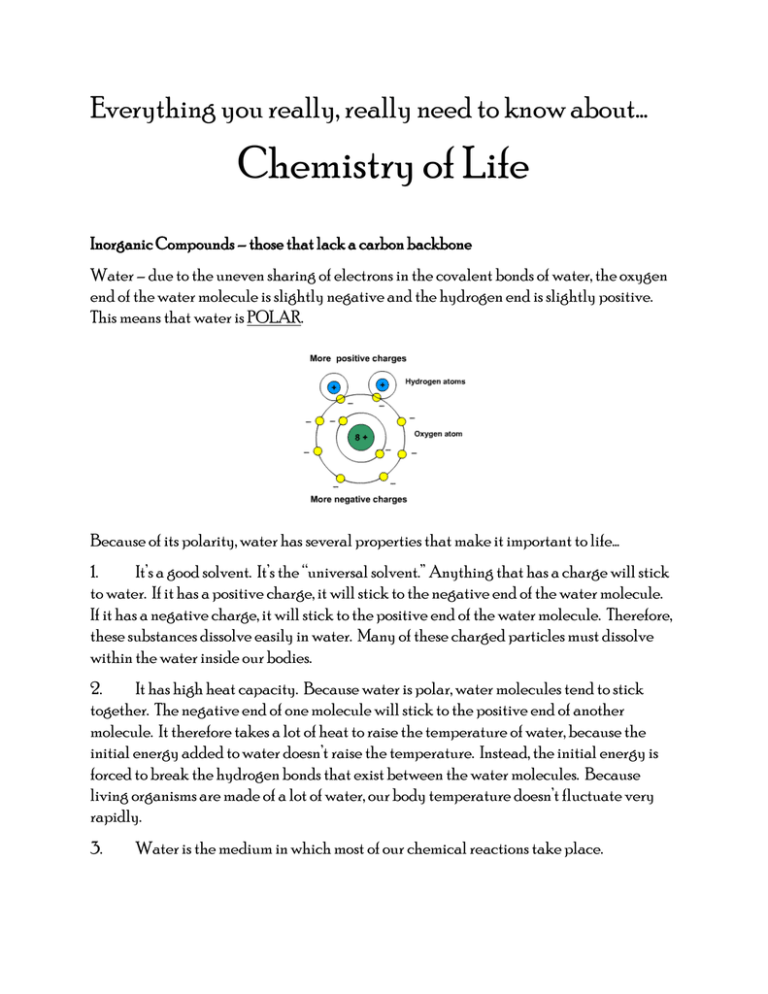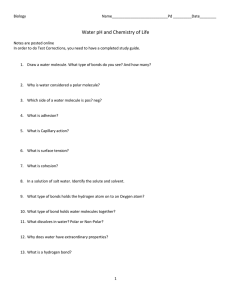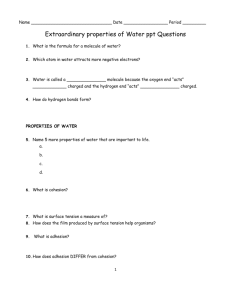Chemistry of Life Everything you really, really need to know about…
advertisement

Everything you really, really need to know about… Chemistry of Life Inorganic Compounds – those that lack a carbon backbone Water – due to the uneven sharing of electrons in the covalent bonds of water, the oxygen end of the water molecule is slightly negative and the hydrogen end is slightly positive. This means that water is POLAR. Because of its polarity, water has several properties that make it important to life… 1. It’s a good solvent. It’s the “universal solvent.” Anything that has a charge will stick to water. If it has a positive charge, it will stick to the negative end of the water molecule. If it has a negative charge, it will stick to the positive end of the water molecule. Therefore, these substances dissolve easily in water. Many of these charged particles must dissolve within the water inside our bodies. 2. It has high heat capacity. Because water is polar, water molecules tend to stick together. The negative end of one molecule will stick to the positive end of another molecule. It therefore takes a lot of heat to raise the temperature of water, because the initial energy added to water doesn’t raise the temperature. Instead, the initial energy is forced to break the hydrogen bonds that exist between the water molecules. Because living organisms are made of a lot of water, our body temperature doesn’t fluctuate very rapidly. 3. Water is the medium in which most of our chemical reactions take place. 4. The solid form of water (ice) is less dense than the liquid form. For this reason, ice floats, allowing life to exist in water below the ice surface. Acids/Bases-determine the pH of our different body fluids and therefore have some control over the chemical reactions that can take place in different parts of our body. Acids form when chemical compounds containing hydrogen release hydrogen ions (H+) into water. The more hydrogen ions released, the stronger the acid. Bases form when chemical compounds containing hydroxide release hydroxide ions (OH-) into water. The more hydroxide ions released, the stronger the base. Acids and bases are measured using something called the pH scale. The scale starts at 0 and ends at 14, with 7 being right in the middle. Seven is important because it represents neutrality between acid and base. In other words, at a pH of 7, there are an equal number of H+ ions and OH- ions. When there are more H+ ions than OH- ions, the solution is an acid and will be represented on the pH scale with a number below 7. When there are more OH- ions than H+ ions, the solution is a base and will be represented on the pH scale with a number above 7. When acids and bases are mixed together, the H+ from the acid and the OH- from the base, combine to form H2O, thus neutralizing each other. This is how buffers are used to maintain pH homeostasis in your body. Organic Compounds – those that have a carbon backbone There are two types of chemical reactions that are very important when it comes to organic compounds. One of those is called a condensation reaction (also known as dehydraton synthesis). A condensation reaction is used to bind smaller molecules (monomers) together to make larger molecules (polymers). In doing so, it removes two H’s and an O from the adjoining molecules, thus forming water. The opposite reaction is called hydrolysis. Hydrolysis takes larger molecules and breaks them down into many smaller ones. It does this by adding a water molecule back in. Carbohydrates – The smallest version of a carbohydrate is called a monosaccharide. Some examples include glucose, galactose and fructose. When two monosaccharides are combined together, it’s called a disaccharide and when even larger carbohydrates are formed, they are called polysaccharides. They are all made of the same basic unit….a monosaccharide. Examples of disaccharides include sucrose, lactose and maltose. Polysaccharides are glycogen, starch and cellulose. The main usage of carbohydrates by living things is for the production of ENERGY. Lipids – This category of organic compounds is composed of fats, oils, waxes and steroids, but we’ll focus on the fats. Fats are composed of two main parts….glycerol and fatty acids. The fatty acids can vary based on the number of hydrogen atoms in them. The more hydrogen atoms, the more saturated the fatty acid. The fewer the number of hydrogens, the more unsaturated the fatty acid. The main usage of fats is in the storage of energy and in the composition of our cell membranes. The body can store more energy in the form of fat than it can in the form of carbohydrates. Proteins – These are different from the previous two types of organic compounds because all proteins contain the element nitrogen in addition to the carbon, hydrogen and oxygen shared by lipids and carbohydrates. The monomer of a protein in called an amino acid and there are about twenty different types of them. Here are just three… To assemble a protein, these and other amino acids are linked together in the correct order. Much of your body (muscles, skin etc…) is made largely of proteins. A special subset of proteins called enzymes, are very important to life. Enzymes act as biological catalysts of chemical reactions. In other words, enzymes help chemical reactions take place within your body, without actually being used up in the process. Enzymes help by speeding up the pace at which a reaction takes place as well as lowering the activation energy necessary for a chemical reaction to get started. Enzymes are very specific. Each different type of enzyme can only catalyze one specific chemical reaction. This occurs because the active site on an enzyme can chemically fit with only one specific set of substrates. For instance, the enzyme, sucrase can break apart the sugar, sucrose. This is the only reaction that sucrase can perform because the substrate, sucrose, is the only substance that will fit in its active site. Also notice that the name of most enzymes ends with the letters –ase. The more enzyme and the more substrate that is present, the more times this reaction will take place. Other factors that affect an enzyme’s ability to work would be temperature and pH. Lower temperatures make an enzyme less active, but higher temperatures can cause the enzyme to denature, meaning that its structure will break down and it will become useless. Therefore, there is an optimal temperature for each different enzyme. The same is true of pH. A pH too high or too low will cause denaturation of the enzyme, rendering it useless.






